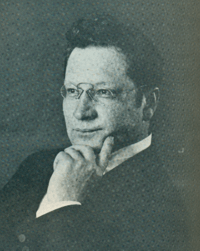John Napoleon Brinton Hewitt
John Napoleon Brinton Hewitt (December 16, 1859 – October 14, 1937)[1] was a linguist and ethnographer who specialized in Iroquoian and other Native American languages. [2] Hewitt was born on the Tuscarora Indian Reservation near Lewiston, New York.[3] His mother was of Tuscarora, French, Oneida, and Scottish descent, his father of English and Scottish, but raised in a Tuscarora family.[4] His parents raised him speaking the English language, but when he left the reservation to attend schools in Wilson and Lockport, he learned to speak the Tuscarora language from other students who spoke the language.[4]

In 1880, he was hired by Erminnie A. Smith of the Smithsonian Institution's Bureau of Ethnology (now the Bureau of American Ethnology), as an assistant ethnologist. He worked with Smith for several years until her death in 1886. He then applied to the institution for employment to complete the Tuscarora-English dictionary he had begun with Smith. He moved to Washington DC where he would work as an ethnologist until his death in 1937. He worked on the dictionary throughout his life, but it was not published during his lifetime. (It was later edited and published as the Tuscarora-English/English-Tuscarora dictionary.[5])
In 1914 he was awarded the Cornplanter Medal.[6]
Hewitt's prolific researches, including studies of Iroquois mythology[7] and language, were compiled in his well-known "Iroquois Cosmology"[8] which was published in two parts, 1903 and 1928.
Sources
References
- Hoxie, Frederick E., ed. (1996). Encyclopedia of North American Indians. Houghton Mifflin Company. pp. 244–245. ISBN 0-395-66921-9.
- "Annual report of the Bureau of American Ethnology to the Secretary of the Smithsonian Institution. v.21 1899-1900". HathiTrust. Retrieved Jun 28, 2020.
- Mann, Barbara A.; Johansen, Bruce E., eds. (2000). Encyclopedia of the Haudenosaunee (Iroquois Confederacy). Westport, Conn: Greenwood Press. pp. 159–160. ISBN 0-313-30880-2.
- Hoxie, Frederick E., ed. (1996). Encyclopedia of North American Indians. Houghton Mifflin Company. pp. 244–245. ISBN 0-395-66921-9.
- Rudes, Blair A. (1999). Tuscarora-English/English-Tuscarora dictionary. Toronto: University of Toronto Press. ISBN 0-8020-4336-4.
- Starr, Frederick (December 1929). "The Later Awards of the Cornplanter Medal". The Open Court. Open Court Publishing Company. 43 (883): 749–755. Retrieved January 9, 2016.
- Hewitt, J. N. B. "Iroquoian Cosmology, First Part". Annual Report of the Bureau of American Ethnology, 1899–1900. 21: 133–339.
- J. N. B. Hewitt (1903). "Iroquoian Cosmology Index". sacred-texts.com. Archived from the original on 2007-10-12. Retrieved 2009-05-25.